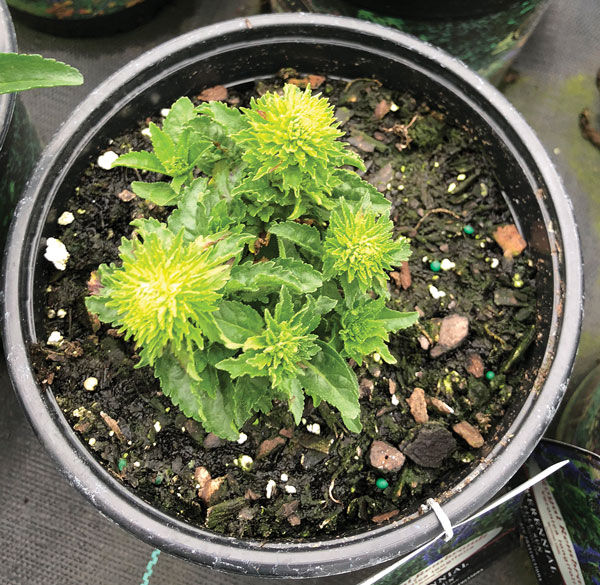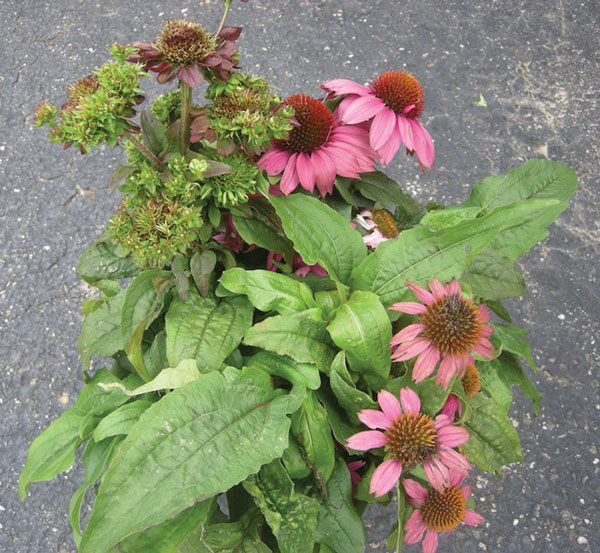8/1/2019
When Yellows Aren’t Attractive
Paul Pilon

I love summer and all the beautiful flowering perennials this season has to offer. However, I’m not so excited when I come across a plant with deformed or proliferated flowers. In many cases, deformed flowers are caused by aster yellows and for most individuals, they’re anything but attractive.
Aster yellows, also referred to as witches’ broom, is an irreversible, viral-like disease that causes plants to appear and grow very abnormally, often forming a massed appearance or brush-like development of numerous weak shoots. Although there are many plants in the aster family that are susceptible to aster yellows, this disorder has been documented on over 40 plant families and has infected well over 200 species of plants worldwide. Perennials particularly susceptible include aster, echinacea, gaillardia, rudbeckia, scabiosa and veronica.
Pictured: Aster yellows on this veronica appears stunted and has a proliferation of chlorotic growth where the flowers are supposed to be developing.
The symptoms can vary widely with differing host plants. Some infected perennials may appear stunted, have chlorotic foliage and develop flower parts with curious abnormalities. Some plants, such as echinacea, develop flower parts that revert back to leaf forms (deformed, yellowish-green flower heads) after they’re infected with aster yellows. Many plants express symptoms with spindly upright leaves, hence the reference to witches’ broom.
Aster yellows is a phytoplasma disease caused by a mycoplasma-like organism that’s often mistaken for plant viruses or bacterial diseases. Phytoplasmas are single-celled micro-organisms (intermediate between bacteria and viruses) that live as parasites in the phloem of plants. Aster yellows is most prominent in outside production systems, but can also be observed inside greenhouses—particularly when the starting materials were previously grown outside, such as when planting perennials from bareroot or from vernalized liners that were grown outside prior to overwintering them.
Aster yellows is vectored from plant to plant by the aster leafhopper (Macrosteles quadrilineatus) and certain other leafhoppers. As mentioned above, there are numerous plants that harbor aster yellows phytoplasma, but annual and perennial weeds around the production site are the most common sources. Additionally, leafhoppers can carry the phytoplasma over very long distances. In fact, aster yellows observed in the northern United States often originates from the South and is moved north with migrating leafhoppers.
Once leafhoppers have acquired the phytoplasma, it takes several weeks of incubation before they can transmit aster yellows to susceptible host plants. Several more weeks are required before plants exhibit symptoms after a leafhopper has vectored the phytoplasma. Once inside the plant, there’s no cure; an infected plant will remain infected even though symptoms may not always be expressed. It's not uncommon for the symptoms to be expressed the following year after the perennials are overwintered.
The best strategy for averting aster yellows is to control the leafhopper populations and keep them from reaching excessive levels. This can be challenging, as leafhoppers move into crop areas from adjoining fields and with air currents. By the time leafhoppers are detected and controlled, it’s very possible they may have already transmitted the phytoplasma. As soon as aster yellows symptoms appear, immediately rogue out and destroy infected plants to prevent the risk of spreading the disease to uninfected plants nearby.
 Pictured: Aster yellows on echinacea can be expressed on all flower parts. Here, the cones are highly distorted, appearing as tightly clustered rosettes. Photo courtesy of Dr. Margery Daughtrey, Cornell University.
Pictured: Aster yellows on echinacea can be expressed on all flower parts. Here, the cones are highly distorted, appearing as tightly clustered rosettes. Photo courtesy of Dr. Margery Daughtrey, Cornell University.
Management strategies should include regular scouting and using sticky cards to detect the presence of leafhoppers. Keep in mind that many weeds are symptomless hosts of aster yellows, which can easily get introduced into the crops by movement of leafhoppers and their subsequent feeding activities. Controlling weeds in and around the production area to eliminate host plants from harboring the disease is one level of prevention. It may be advantageous to produce susceptible, high-value crops, such as echinacea, in a screened facility, which prevents leafhoppers from entering the crop area.
If leafhoppers are present, it’s important to keep their population from reaching excessive levels. Growers can obtain some control using contact insecticides—such as acephate, bifenthrin, carbaryl, cyfluthrin, pyrifluquinazon, tolfenpyrad—and with horticultural oils or insecticidal soaps. Controlling leafhoppers can be difficult, as leafhoppers are very mobile and new leafhoppers often enter the treated area after the sprays have dried. Several systemic products containing the active ingredients acetamiprid, flupyradifurone, imidacloprid, spirotetramat and thiamethoxam are effective and offer extended control with less frequent applications. GT
Paul Pilon is a Perennial Production Consultant and editor-at-large of the Perennial Pulse e-newsletter. Feel free to contact him with article topics or to address your perennial production challenges. He can be reached at paul@perennialsolutions.com.